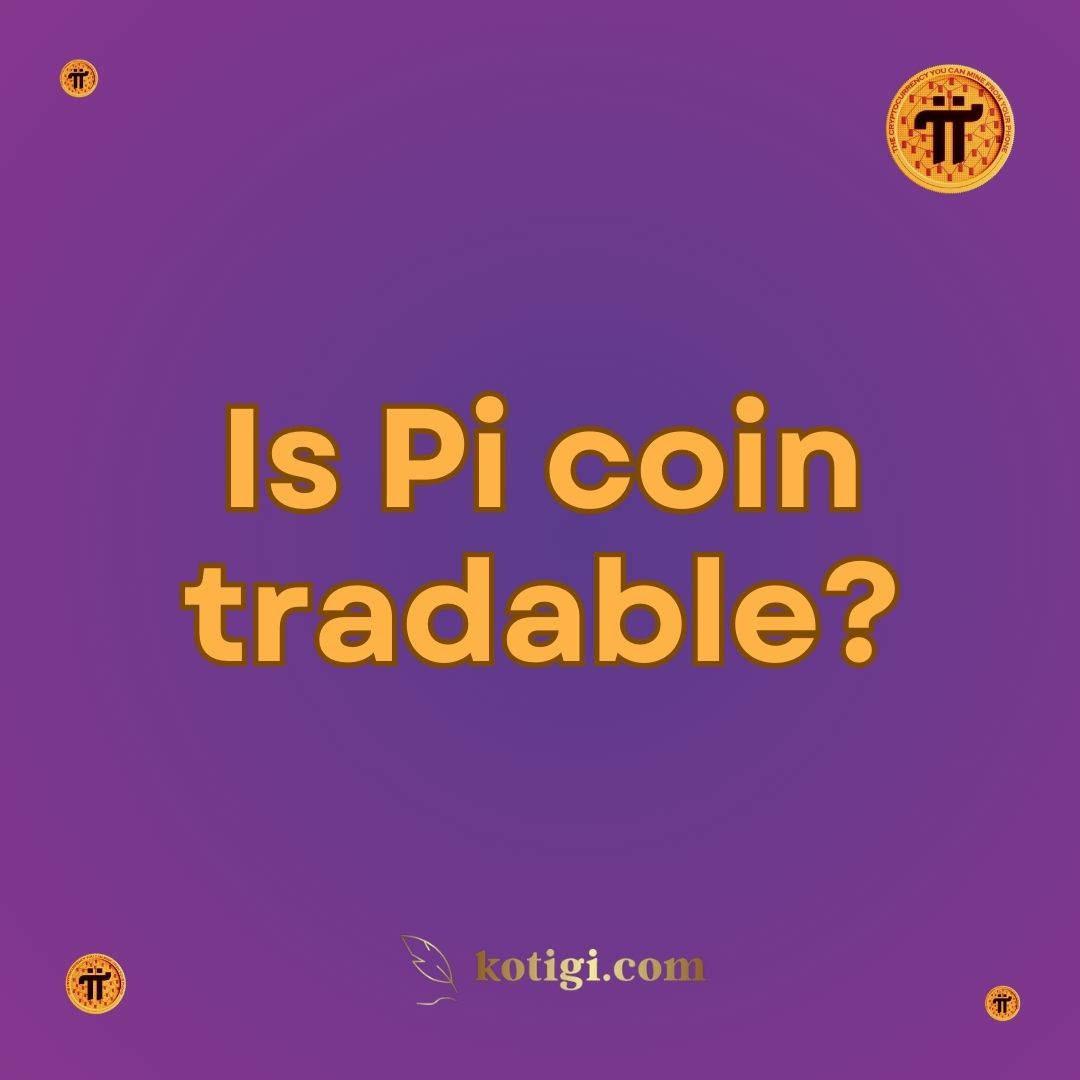
Is Pi coin tradable?
Currently, Pi coin is not tradable on any exchanges. Pi Network is still in its Enclosed Mainnet phase, meaning that Pi can only be used within the network’s ecosystem. Once Pi transitions to the Open Mainnet, it will become tradable, but until then, users cannot buy, sell, or exchange Pi on external platforms.
Introduction
Pi Network has gained a massive user base, with millions of people mining Pi coins using their smartphones. However, despite the excitement surrounding the project, many users are curious to know if Pi coin is currently tradable on cryptocurrency exchanges. In this article, we’ll dive into whether Pi coin can be traded, the current state of Pi’s development, and what the future holds for Pi coin trading.
What Is Pi Coin?
The Basics of Pi Network
Pi Network is a cryptocurrency project that allows users to mine Pi coins using their smartphones without the need for energy-intensive mining hardware. The project aims to make cryptocurrency accessible to everyday users by using a more eco-friendly and user-friendly consensus algorithm.
What Is Pi Coin Used For?
As of now, Pi coin has limited use since it cannot be traded on exchanges. Pi coins can only be mined and held within the Pi Network ecosystem. The project aims to build a decentralized marketplace where users can spend Pi on goods and services, but this is still in development.
The Role of Pi Coin in the Ecosystem
The Pi coin is intended to be the native currency of the Pi Network. Once the project launches its Open Mainnet, Pi coin will be used for transactions within the decentralized marketplace, decentralized applications (dApps), and possibly for trading on external cryptocurrency exchanges.
Is Pi Coin Currently Tradable?
Can You Trade Pi on Exchanges?
As of now, Pi coin is not tradable on any cryptocurrency exchanges. Pi Network is still in its Enclosed Mainnet phase, meaning that the coin is only accessible within the network itself. Users can mine and hold Pi, but they cannot sell, trade, or exchange it outside of the Pi ecosystem.
What Is the Enclosed Mainnet Phase?
The Enclosed Mainnet refers to the current phase of Pi Network, where the blockchain is live, but transactions and trading are limited to internal transfers between users within the network. This phase allows the team to test the functionality of the network and ensure that it is secure before launching the Open Mainnet.
Will Pi Be Tradable in the Future?
Yes, once Pi Network transitions to the Open Mainnet, Pi coin will become tradable on external exchanges. This means that users will be able to buy, sell, and trade Pi just like other cryptocurrencies, such as Bitcoin or Ethereum.
What Needs to Happen for Pi to Become Tradable?
The Transition to Open Mainnet
For Pi coin to become tradable, the project must successfully transition to its Open Mainnet. This is the final phase of Pi’s development, where the network will be fully decentralized, and Pi can be traded on exchanges. The timeline for the Open Mainnet launch has not been confirmed, but it is expected to happen once Pi Network completes its KYC (Know Your Customer) verification process for a significant portion of its user base.
Why Is KYC Important?
KYC is critical for ensuring that the network is composed of legitimate users and not bots or duplicate accounts. Without KYC, Pi Network risks fraud and malicious activity, which could undermine the value and security of the Pi ecosystem. Completing KYC is also a regulatory requirement for listing Pi on exchanges.
Exchange Listings
Once Pi moves to the Open Mainnet, it will need to be listed on cryptocurrency exchanges. This will involve meeting certain technical and regulatory requirements to ensure that Pi can be traded in compliance with global financial regulations. Popular exchanges like Binance, Coinbase, and Kraken could be potential platforms for Pi trading, but this will depend on Pi Network’s development and compliance with regulatory standards.
How Will Pi’s Value Be Determined Once Tradable?
Supply and Demand
The value of Pi will be determined by the basic principles of supply and demand once it becomes tradable. If there is high demand for Pi, but the supply is limited, the price of Pi could increase. On the other hand, if there is an oversupply of Pi and low demand, the price could decrease.
Market Perception
Another key factor that will influence Pi’s value is market perception. If users and investors believe that Pi has real-world utility and potential for growth, they may be more likely to buy and hold Pi coins, which could drive up its value. Conversely, if there is skepticism about the project or delays in the Mainnet launch, the price could be affected negatively.
Initial Trading Volatility
Like many cryptocurrencies, Pi may experience significant price volatility when it first becomes tradable. Early trading could see sharp price fluctuations as users rush to buy, sell, or hold Pi. Over time, the market should stabilize as Pi gains traction and finds its place in the broader cryptocurrency ecosystem.
What Will Pi Be Used For Once Tradable?
Decentralized Applications (dApps)
Once the Open Mainnet is launched, Pi Network aims to support the development of decentralized applications (dApps) that will use Pi coin as the primary currency. These dApps could include everything from decentralized finance (DeFi) platforms to gaming and social applications.
Marketplace for Goods and Services
Pi Network also envisions creating a decentralized marketplace where users can buy and sell goods and services using Pi coins. This marketplace will be an essential part of the Pi ecosystem, providing real-world utility for Pi holders and helping to establish Pi as a legitimate cryptocurrency.
Trading on Exchanges
Once Pi is listed on exchanges, users will be able to trade Pi for other cryptocurrencies or fiat currencies. This will open up liquidity for Pi and allow users to convert their mined Pi into other assets.
What Are the Risks of Trading Pi?
Regulatory Uncertainty
One of the biggest risks facing Pi Network is regulatory uncertainty. Cryptocurrencies are subject to changing regulations worldwide, and Pi Network will need to comply with these regulations to be listed on exchanges and used for real-world transactions. Failure to comply with regulatory standards could limit Pi’s tradability and use.
Market Speculation
Another risk is the potential for market speculation. Like many new cryptocurrencies, Pi could be subject to speculative trading, where investors buy and sell the coin based on hype rather than its real-world utility. This could lead to price volatility and uncertainty in Pi’s value.
Technical Challenges
Pi Network must also address technical challenges before becoming tradable. Ensuring that the blockchain is secure, scalable, and functional will be critical for the success of Pi as a tradable cryptocurrency. Any technical failures could damage user confidence and affect Pi’s value on the market.
How to Prepare for Pi Trading?
Completing KYC
If you want to trade Pi once it becomes available on exchanges, the first step is to complete the KYC process. This will ensure that you are eligible to send, trade, and use Pi once the Open Mainnet is launched.
Monitoring Exchange Listings
Once the Open Mainnet is live, Pi Network will likely announce its listings on cryptocurrency exchanges. Keeping an eye on these announcements will help you know when and where Pi will be tradable.
Managing Your Pi Portfolio
Before Pi becomes tradable, it’s essential to plan your strategy for holding, trading, or using Pi. Some users may choose to hold Pi in the hopes that its value will increase over time, while others may look to trade it early for other assets.
Conclusion
As of now, Pi coin is not tradable on any exchanges, and users cannot buy, sell, or trade Pi outside the Pi Network ecosystem. However, once the project transitions to its Open Mainnet, Pi will become tradable, opening the door to exchange listings and real-world utility. For now, users can mine and hold Pi while they wait for the network’s development to progress. The future of Pi trading looks promising, but it will depend on the successful launch of the Mainnet, exchange listings, and broader user adoption.
Key Takeaways:
- Pi coin is not tradable yet, as Pi Network is still in its Enclosed Mainnet phase.
- The transition to the Open Mainnet will make Pi tradable on cryptocurrency exchanges.
- Users must complete the KYC process to participate in Pi trading.
- Pi’s value will be determined by supply, demand, and market perception once it becomes tradable.
- Risks such as regulatory uncertainty, market speculation, and technical challenges could impact Pi’s tradability and long-term success.





